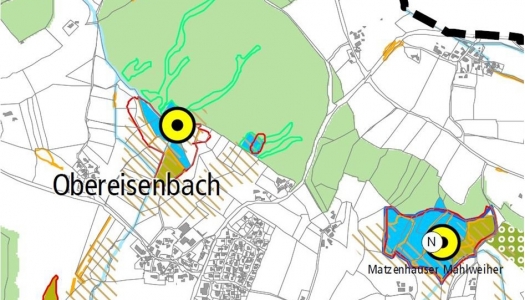
Flowering meadows instead of parking spaces
A living roof for the VAUDE Manufaktur
After a fire in 2015, we built a new production facility for our Made in Germany products. Biodiversity also played an important role in the project: The Manufaktur has a living roof. 1500 square meters of green thermal insulation in winter and cooling in summer!
This not only creates a habitat for plants and insects, but also helps us save energy and serves as natural acoustic insulation against rain and hail.
At the same time, more than half of our annual precipitation evaporates due to water retention on the green roof. This reduces the impact of rapidly draining surface water on our urban drainage and sewage treatment plants.

1,500 square meters of parking space unsealed and greenscaped
As part of our major building conversion in recent years, we have completely unsealed a good 1,500 square meters of parking space in the inner courtyard. Instead of parked cars, a species-rich, low-nutrient grassland wilderness dedicated to alpine vegetation is now blooming here. A paradise for insects and a feast for the eyes of all employees and guests.
Herbs and grasses of different habitats from sunny to shady are growing on the terraces of our organic canteen. (Peppermint leaf tea, anyone?)
In addition, we have planted 5,000 early flowering daffodils, crocuses and scilla to feed insects in spring. We have installed nesting boxes for songbirds and bats, and renaturalized a stream that flows through the area. We regularly remove the invasive Indian balsam, which displaces native species but provides little food for insects.
The idea for these measures came from a Biodiversity Check that helped us evaluate our points of contact and potential for action. Read more here.
VAUDE in the regional Biotope Association
The VAUDE company headquarters in Tettnang-Obereisenbach are located on the southern outskirts of Obereisenbach, a small town near Lake Constance in southern Germany. The area borders on a settlement in the north and on meadows and forests used for agriculture and forestry in the east, south and west.
The headquarters include: product development, administration, logistics, the Manufaktur for our bag production, maintenance and our Kinderhaus childcare center.
The VAUDE property measures a total of 40,372 m2. 49 percent of this area is paved or cultivated. 2,200 m2 of the paved outer surface consist of a special drain stone pavement for a parking lot that is also used for large events. This drain stone does not seal the surface completely but allows rainwater to seep through, while also preventing the surface from heating up too much and allowing small organisms to live in between the cracks.
The VAUDE outlet store and a certified organic VAUDE Café, which also serves employees as a cafeteria, are located on the western edge of Obereisenbach. This area measures 3,290 m2, of which 94 percent is paved.
Excerpt from: Biotope survey 2002
Schmelzer + Friedemann

|
Landscape Plan 2002
The blue and olive surfaces are hay meadows, the yellow dots indicate regional species, the shaded areas are marshes, and the red and green borders are nature conservation areas. |
According to the 2002 biotope mapping of the Tannauer Valley, compensatory measures for construction sites are to be primarily carried out in the biodiversity "hot spots" specified therein. This also includes, in VAUDE’s case, the Obereisenbach pond, where a restoration project for hillside springs and hay meadows is used as a compensatory measure for our building operations.
Above-average species potential at the VAUDE site
Tettnang-Obereisenbach is located in the biogeographic transitional area between the Lake Constance basin and the West Allgäu hills. With 83 target species (animals), the municipal area has a very high species potential that is above average for Baden-Württemberg communities.
13 species are Category A species - species that are threatened with extinction nationwide. Where they still can be found, these species are primarily isolated, predominantly unstable or acutely threatened. Immediate conservation assistance is needed for these species. The majority of the species of this category living in the Tettnang-Obereisenbach municipality can be found in small areas in natural bogs that are currently being maintained as wild flower meadows. (From the “Biodiversitäts-Check am Beispiel Tettnang-Obereisenbach”, Dr. U. Schuckert und T. Friedemann, BWGZ 10/2012
Four threatened species
Four of the 13 endangered species in Baden-Württemberg live on VAUDE’s premises.
- Marsh Fritillary (Euphydryas aurinia)
- Tufted Marbled Skipper (Carcharodus floccifera)
- Scarce Large Blue (Maculinea teleius)
- Geyer’s Whorl Snail (Vertigo geyeri)
As habitats, these species require semi-natural moors, such as those still cultivated in the Tettnang-Obereisenbach area as wild flower meadows.

|
Our Location
In Tettnang-Obereisenbach we have control over how we deal with biodiversity. We need to raise even more awareness among our suppliers. |
Species introduced by sea freight
The introduction of invasive species by ocean freight from our production countries poses a potential risk to biodiversity at our Obereisenbach headquarters.
There is still a lot of room for improvement in our supply chain to protect biodiversity. So far, this has played virtually no role in the industry. The Higg Index now also addresses the issue of deforestation, which has a direct impact on biodiversity.
Our strict criteria for the materials we use in our VAUDE products and our Environmental Stewardship Project with suppliers are two important steps.
However, we still have a lot of work to do to raise the awareness of our service providers and business partners.
| GRI: | 304-1 |
| GRI: | 304-3 |
| GRI: | 304-4 |




